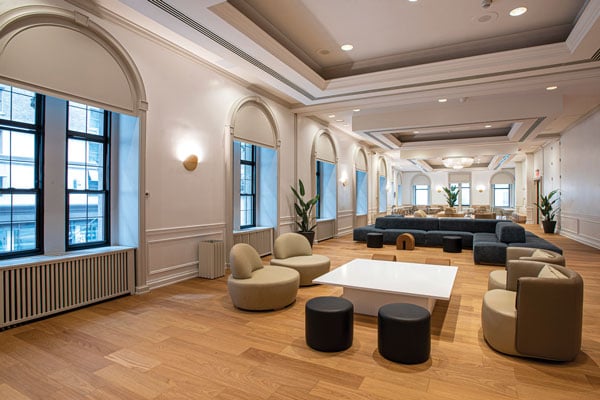
Reinventing Hotels as Housing
Whether for dormitories or apartments, converting underperforming hotels in urban markets shows promise.
In major metropolitan areas nationwide, two market trends are converging: a soaring increase in demand for new housing and a decrease in demand for extended-stay and full-service hotels. For example, while demand for affordable, market-rate and student housing is as high as it has ever been in New York, lodging loan delinquency rates there are above 15%, according to an August 2023 article from data and analytics firm Trepp.
One possible solution is to convert underperforming hotel properties into permanent housing — for students, the workforce, younger families and other populations. Even some longtime hoteliers, who tend to be reluctant to embrace conversion, are recognizing that selling to a multifamily developer or pivoting to developing housing themselves may be the right move. At the same time, there is the owner-investor class who bought stressed hotels while the pandemic was at its height but now find that the market has not achieved the return they had imagined.
Incentives are feeding into conversion growth. At both the city and state levels, policymakers in Arizona, California, Missouri, New York and other regions with large metropolitan areas have been crafting legislation that streamlines the conversion process and makes the value proposition more appealing. Examples include Senate Bill S5080B, currently in committee in the New York Senate, and AB 1532, which was enacted in California in 2023.
Some legislative efforts are focused on rapidly turning vacant office buildings into below-market-rate housing, although it should be noted that office buildings tend to be more challenging for dormitory and apartment conversions because of factors such as low window-to-floor-area ratios and deeper floor plates. Hotels generally are already designed with outdoor views, exposure to daylight, and air circulation in mind.
In the case of student housing, developers in cities where higher education and research science have a large presence have been finding enthusiastic partners among institutional leadership, who regularly grapple with housing shortages for students and researchers.
Identifying the Right Property
As in most investment situations, location is critical. Developers of conversion properties start with locations that have already been selected, which adds a new onus: The project team must be certain the location is an appropriate site for the most appealing housing models. For example, in dense urban settings, savvy developers and investors evaluate a range of amenities within walking distance. Similarly, a student housing complex should be proximate to the higher education institution where the residents attend class or work.
The project team’s focus then shifts to considering the economics of the existing property and proposed conversion model. The task is to identify a building that requires only a limited amount of work before achieving a certificate of occupancy. Lead times for critical materials and components should also be considered when identifying a candidate property. It’s simple enough to find substitutes for finishes such as flooring, wall coverings and kitchen cabinets, but if critical infrastructure components such as electrical switchgear, mechanical units and fire alarm devices cannot be procured on time, there’s a good chance the project won’t succeed. The best building for the job is the one with the most pieces already in place, which should reduce both cost and schedule for construction. For planning purposes, $350-$400 per square foot is a reasonable figure to consider, although the geographic region and intended scope of work, among other factors, can cause this baseline number to vary.
If the elevators work and the existing electrical and mechanical infrastructure are healthy and robust, that’s a good start. It’s even better if the building’s electrical capacity is high. (This happens to be the case with many full-service hotel structures, which are built to accommodate events that create a spike in demand for electricity, hot water, air conditioning and other utilities or services.) Walls and ceilings are easier to renovate or replace, as are finishes like carpeting and wallpaper, adding little to the overall construction timetable. Shared hotel amenities such as fitness rooms and lounges generally translate well to the housing model, with only modest retrofits and updates needed. The ideal property will also have space and infrastructure for adding amenities such as a mail room, 24-7 security and Wi-Fi.
The Integrated Delivery Approach
With business cycles continuing to shrink and the evolution of consumer habits accelerating, speed-to-market for these conversion projects is critical. The key to staying on schedule for opening is to integrate the contractor into the project at the earliest possible stage, including site selection and “pre-design” project definition.

Former shared hotel amenities such as lounges are often a good fit for the student housing model, generally requiring only modest retrofits and updates. Erik Rank, courtesy BDB Construction
Consider the 2022 conversion of an 800-key Hilton Doubletree in Midtown Manhattan into a complex of student apartments. Leaders of LIM College, one of the institutions planning to lease the property, wanted the apartments to include en suite kitchens, a decision with major implications for construction scheduling and for building and life-safety code compliance. Resolving the issues related to plumbing and electrical service presented significant hurdles for timely completion and a certificate of occupancy.
Involved from the earliest phases, the contractor kept the developer’s planned construction timetable on track. The integrated delivery approach allowed the team to coordinate and sequence shipments and activity, ensuring that the needed electrical and safety system upgrades would be completed on time, without affecting the owner’s budget. The approach also allowed the contractor to identify shortcuts that would pass muster with inspectors, such as accessing the supplemental electrical capacity that the hotel had as part of its infrastructure.
Just seven months after closing on the Hilton Doubletree property in early 2022, a temporary certificate of occupancy was issued, and LIM College students began moving in for the fall semester. One month later, the apartment complex was nearly fully occupied.
Planning for the Unexpected
Conversions are complex. No two are exactly alike, and there will always be challenges, but with nimble and experienced project partners working closely together from project inception to integrated delivery, those challenges can be anticipated and appropriately managed. The developer will want each team member to be familiar with the conversion type, and with the local laws and codes that so often create unexpected impediments to construction.
For example, another large-scale student housing conversion in Manhattan involved a former Marriott property in a landmark building with an iconic facade. It was simple enough to conform to historic preservation requirements, but New York City also enumerates strict requirements for building facades under Local Law 11, which aims to protect passersby from being injured by falling debris. (In 2019, the death of a person struck by a fallen facade component led to criminal charges under the 1998 statute.) Aware of these requirements from the outset, the integrated delivery team folded facade repairs into the construction planning and sequencing, ultimately completing the project and beginning the occupancy phase on the originally proposed schedule. Just seven months after close of sale in early 2023, housing provider FOUND Study Turtle Bay offered 1,355 dormitory beds serving students at New York Institute of Technology and Manhattan Marymount College.
For developers identifying an urban hotel property that is underperforming in their portfolio or that is available for purchase and who believe that it can be converted into permanent housing due to its location, structural conditions and available amenities, the most important next step is to assemble and integrate the ideal project team. This will save time and money because an integrated project construction and delivery approach streamlines the process.
Tallal Bhutta is founder and CEO of BDB Construction Enterprise Inc., a construction provider based on Staten Island.
Hotels vs. Office BuildingsA July 2023 RentCafe study analyzing commercial real estate data from Yardi Matrix found that Los Angeles, New York, Chicago, Philadelphia and Cleveland were the top five markets for future adapative reuse conversions. The same study reported that hotels accounted for nearly a third of conversions to housing in 2022; in the same year, only office buildings outpaced hotels for residential retrofits. |




